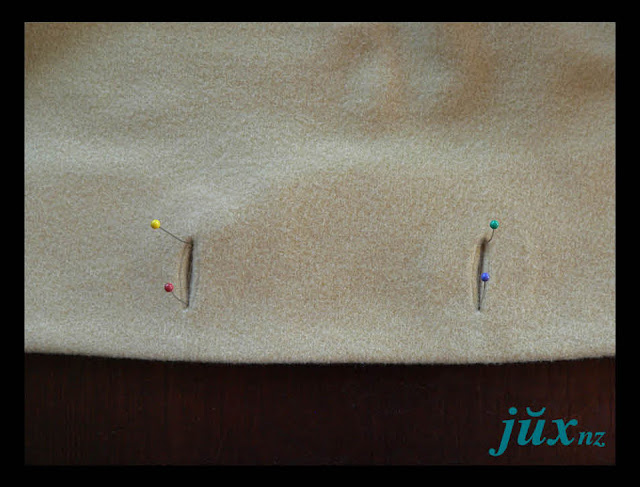I’ve been making bound buttonholes for years, but have often been frustrated at how large the “lips” are, no matter what I did to make them smaller.
Then last weekend I discovered Spanish Snap Buttonholes in a book I’ve had for ages “Couture - the art of fine sewing” by Roberta Carr. Now, I have to admit, I often overlooked this book in favour of others in my collection because of the photos inside - eyewatering 1980’s outfits (be aware!). I’m taking a fresh look at it now to see what other techniques it contains for future use.
I found these buttonholes were much easier to make than regular bound buttonholes. Here’s how:
First, make a oval template on a bit of cardboard 7.5cm (3 inches) by 5cm (2 inches). Make a rectagular box first, mark in centre lines and freehand the curves.
Find the true bias of your fabric (absolutely crucial to use the bias so the lips wrap correctly) and on the wrong side chalk the bias line, or use a basting stitch if you prefer. Centre your oval template longways on this line and mark up as many ovals as you need for buttonholes, plus one for a trial run.
Once you cut them out, mark the centre point of each oval, then measure and mark half the width of your button on each side of this centre point (longside). Mark out 3mm (1/8 inch) each side of centre point (shortside). These are the points you’ll stitch to in curved lines. You can chalk/baste the whole stitching line if you like.
Next, mark the position of the buttonholes on the right side of your garment. Centre each oval wrong side up over this line in the correct distance from the front edge for the size of your button; pin in place. In this example, my buttons are 28mm, therefore the ovals sit 1cm in from the front edge. (If they were much smaller, I imagine the ovals would extend past the garments edge.)
Now, using a small stitch length on your machine, stitch an ‘squinty eye’ shape with pointy ends. Slash through the centre and out to the points, being careful not to cut the stitching.
Turn through to the wrong side of garment, take hold of each end of the oval and tug once in a firm ‘snap’. Voila! The bias will wrap neatly around the seams and you have made a lovely buttonhole.
Press. I found I could press them to either have no lips or really narrow ones (which are demonstrated here).
If necessary, trim oval to sit back from the seam allowance.
(Ms Carr suggested pressing a little fusible web at each end to keep in place, but I didn’t bother, because once they’re stitched to the facings they’ll hold in place.)
As you can see, I’ve now sewn my jacket and attached the facings, but not the lining.
To make the buttonhole facings, place a pin in the corner of each buttonhole, right through the facing.
Flip the garment over and chalk/baste the buttonhole points onto the facing, using the pins as a guide. (If you look closely, you’ll see yellow-head pins pointing to my white chalk marks).
Cut retangles of fusible interfacing 7.5cm (3 inches) by 5cm (2 inches) – use those scraps you’ve been saving! Chalk/baste buttonhole markings onto the sticky side of the fusible, and pin to the facing, right sides together.
Once again, using a small stitch length on your machine, stitch an ‘squinty eye’ shape just past the chalked/basted points of the buttonhole. Before you cut, pin through the buttonhole to check again they’re lining up, then slash through the centre and out to the points, being careful not to cut the stitching.
Push the fusible through the hole, and trim to sit within the seam allowance. Carefully press fusible to the facing. (Of course a cat had to get in at least one picture!)
Line up your buttonholes and facings and pin and/or baste.
When you have finished your garment, slip-stitch the facings to the buttonholes.
Gorgeous!











8 comments:
Great tutorial! Your explanation is great. Thank you for including the part about the facings too.
You're welcome!
I'm getting ready to make a coat which calls for bound buttonholes and I'm doing this method instead! Thank you sew much for this tutorial!
So sorry for the late reply. Hope the coat went well - did you use this method in the end? Thanks for stopping by and commenting.
Your tutorial is terrific! I've been looking for this method and found a mention and link on PatternReview.com. I'm convinced now, this will be perfect for the wool cape coat I'm starting today, fabric all cut, marked and ready to go.
Steph A @ escapadesinsewing.blogspot.com
Thank you for this helpful tutorial that explains how to do the facing for Spanish Snap buttonholes. I understood how to do the front, but never found an explanation for how to work the buttonholes in the facing. Your coat in the post looks beautiful. I hope that you have been enjoying it.
McAfee Login is the most important process when it comes to using your antivirus program. Without logging into your McAfee account, you won’t be able to manage your subscription. If you’re facing any kind of mcafee login, mcafee login problem, it might be due to the wrong password or id. Try typing your McAfee id and password again, or contact us for more help.
Thank you so much for this! Can’t wait to try this technique.
Post a Comment